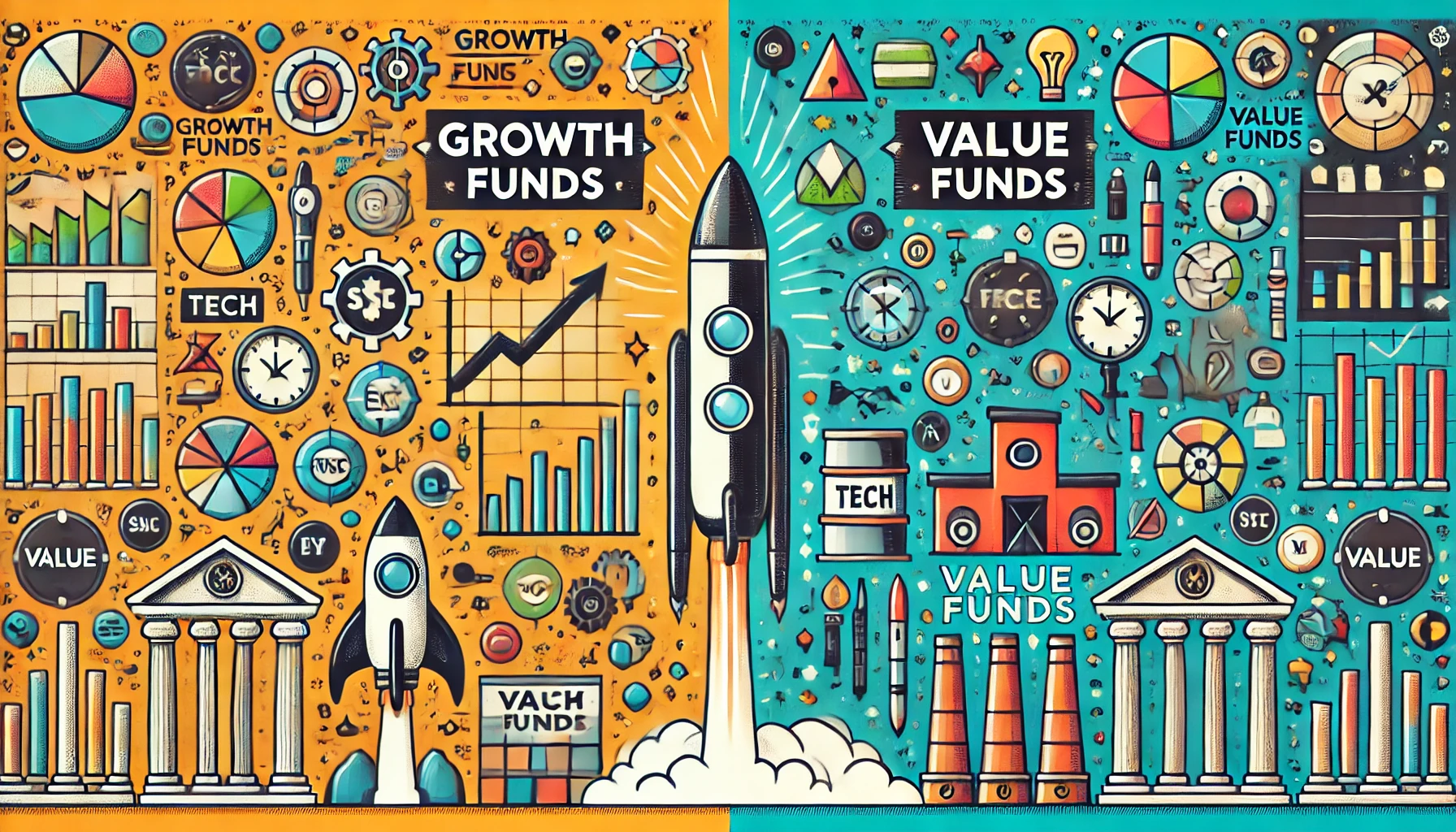Investing in the stock market can seem overwhelming, especially with the myriad of options available. Among these, growth funds and value funds stand out as two prominent investment strategies. While both aim to increase investors’ wealth, they do so through different methodologies. In this article, we’ll delve into growth funds and value funds, exploring their distinct characteristics, benefits, and risks. By the end, you should have a comprehensive understanding of which approach might suit your financial goals better.
What Are Growth Funds?
Growth funds focus on companies that exhibit signs of above-average growth. These companies are often in their expansion phase and reinvest their earnings to fuel further growth. As a result, they typically do not pay dividends, opting instead to increase their stock value.
Characteristics of Growth Funds
- High Potential for Capital Appreciation: Growth funds aim for stocks that are expected to grow at an above-average rate compared to other companies.
- Reinvestment of Earnings: Instead of paying dividends, these companies reinvest earnings into the business to promote further growth.
- Higher Valuation Ratios: Growth stocks often trade at higher price-to-earnings (P/E) ratios because investors are willing to pay a premium for anticipated growth.
Advantages of Growth Funds
- Potential for High Returns: Given their focus on growing companies, growth funds can yield significant returns, especially in a booming economy.
- Innovation and Market Leadership: These funds often include companies at the forefront of innovation and market trends.
Risks of Growth Funds
- Higher Volatility: Growth stocks can be more volatile, leading to larger price swings.
- No Dividends: Investors looking for regular income might find growth funds less appealing as they typically do not pay dividends.
What Are Value Funds?
Value funds invest in companies that are undervalued by the market. These companies typically have solid fundamentals but are priced lower than their peers. The idea is to buy these stocks at a discount, with the expectation that their value will eventually be recognized by the market.
Characteristics of Value Funds
- Undervalued Stocks: Value funds look for stocks trading for less than their intrinsic value.
- Dividends: Many value stocks pay dividends, providing a steady income stream.
- Lower Valuation Ratios: Value stocks usually have lower P/E ratios compared to growth stocks.
Advantages of Value Funds
- Lower Risk: Since value stocks are already undervalued, there is potentially less downside risk.
- Income Generation: The dividend payments from value stocks can provide a consistent income stream.
Risks of Value Funds
- Potential for Slow Growth: Value stocks might take longer to appreciate, requiring patience from investors.
- Misjudged Value: There is a risk that the stock might be undervalued for a good reason, such as fundamental business issues.
Comparing Growth Funds and Value Funds
When deciding between growth and value funds,
Growth Funds vs. Value Funds: Key Differences
Understanding the primary differences between growth funds and value funds is essential for making an informed investment decision. Here, we break down the key contrasts between the two investment strategies.
Investment Focus
- Growth Funds: Focus on companies with strong potential for future growth. These companies are typically in the tech, healthcare, and consumer discretionary sectors.
- Value Funds: Concentrate on companies that are undervalued compared to their intrinsic worth. These companies often belong to more established industries like utilities, financial services, and industrials.
Risk and Return Profile
- Growth Funds: Higher risk with the potential for higher returns. Due to their reliance on future growth, these funds can be more volatile, especially during market downturns.
- Value Funds: Generally lower risk and more stable returns. They provide a cushion against market volatility, as their stocks are already trading at lower prices.
Income Generation
- Growth Funds: Typically do not pay dividends, focusing instead on capital gains.
- Value Funds: Often pay regular dividends, providing investors with a steady income stream.
Market Conditions
- Growth Funds: Perform well in a bull market when the economy is expanding and consumer confidence is high.
- Value Funds: Tend to outperform during bear markets or economic downturns, as their lower valuations make them less susceptible to market fluctuations.
The Benefits of Diversifying with Both Growth and Value Funds
Investors often debate whether to choose growth funds or value funds. However, the optimal investment strategy may lie in diversification. Combining both growth and value funds in a portfolio can balance the risk and reward dynamics. By integrating these two approaches, investors can take advantage of capital appreciation from growth stocks during economic booms and steady income from value stocks during market downturns.
Why Diversification is Key
- Reduced Volatility: Diversifying with both types of funds can help smooth out the highs and lows of the market, providing a more stable return over time.
- Balanced Risk: While growth funds offer higher potential returns, they come with increased risk. Value funds, on the other hand, provide stability and income. A mix of both can create a well-rounded portfolio.
- Adaptability to Market Changes: Economic conditions fluctuate, and different types of stocks perform better under different circumstances. Diversifying allows investors to benefit from both upswings and downturns.
Practical Tips for Investors
- Assess Your Risk Tolerance: Determine how much risk you are comfortable taking on. Growth funds might be suitable for aggressive investors, while value funds might appeal to those seeking stability.
- Consider Your Investment Horizon: If you have a long-term horizon, you might afford to take more risks with growth funds. For short-term goals, value funds might be safer.
- Regularly Rebalance Your Portfolio: Market conditions change, and so should your portfolio. Periodically review and adjust your investments to maintain the desired balance between growth and value funds.
Case Studies: Real-World Examples
Example 1: Tech Boom and Growth Funds
Consider the tech boom of the 2010s. Investors who put their money into growth funds that focused on technology companies saw significant returns. Companies like Apple, Amazon, and Google (now Alphabet) experienced exponential growth, driving the value of growth funds up.
Example 2: Financial Crisis and Value Funds
During the 2008 financial crisis, many growth stocks plummeted. However, investors with value funds, which included financially stable and undervalued companies, experienced less severe losses. These funds often contained companies with solid balance sheets and consistent dividend payments, providing a buffer during economic turmoil.
Making the Right Choice: Personalizing Your Investment Strategy
Evaluate Your Financial Goals
- Short-Term Goals: If you need money in the near future, value funds might be a better option due to their stability and dividend payments.
- Long-Term Goals: For long-term growth, investing in growth funds can provide substantial returns, albeit with higher volatility.
Consider Your Investment Experience
- Novice Investors: Those new to investing might prefer the relative safety of value funds.
- Experienced Investors: Individuals with more market knowledge and a higher risk tolerance might find growth funds more attractive.
Monitor Market Trends
Staying informed about market conditions can help you make better investment decisions. Economic indicators, industry trends, and company performance are all factors that can influence the success of growth and value funds.
Stay Informed and Educated
The investment landscape is constantly evolving. Continuously educating yourself on market trends, economic conditions, and individual company performance can help you make informed decisions and optimize your investment strategy.
Conclusion
Choosing between growth funds and value funds depends on various factors, including your risk tolerance, investment horizon, and financial goals. While growth funds offer the potential for high returns through capital appreciation, they come with higher volatility. On the other hand, value funds provide more stability and income through dividends but might offer slower growth.
A balanced approach, incorporating both growth and value funds, can provide a comprehensive strategy that leverages the strengths of each type of investment. By understanding the differences and benefits of each, you can tailor your investment strategy to meet your unique needs and achieve your financial objectives.
Key Takeaways:
- Growth funds focus on companies with high growth potential and typically reinvest earnings rather than paying dividends.
- Value funds invest in undervalued companies with solid fundamentals, often providing steady dividend income.
- Diversifying with both growth and value funds can balance risk and reward in your portfolio.
- Consider your risk tolerance, investment horizon, and financial goals when choosing between growth and value funds.
Investing wisely requires a thorough understanding of your options and a strategy tailored to your financial situation. By analyzing growth funds and value funds, you can make informed decisions that align with your long-term investment goals.

